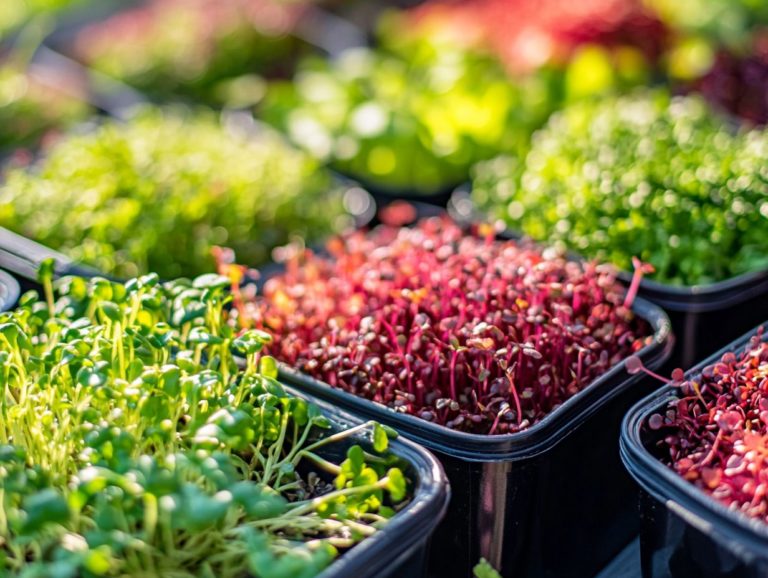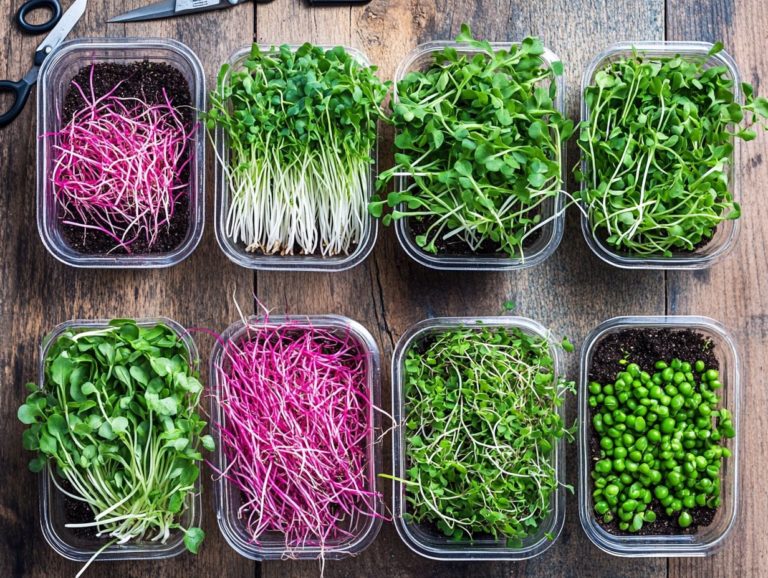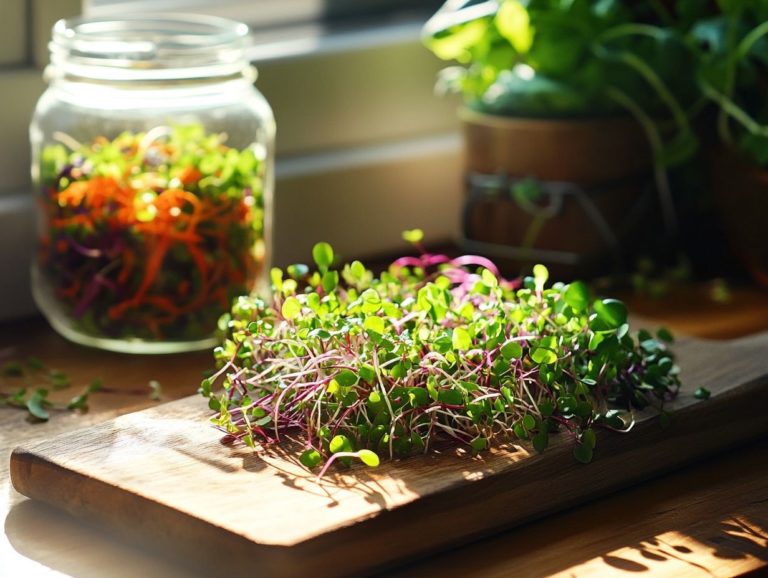Nutritional Benefits of Common Microgreens
Microgreens are tiny, nutrient-packed wonders that have taken the culinary scene by storm. Often dubbed ‘vegetable confetti’, these vibrant greens are not just a feast for the eyes; they re also a powerhouse of nutrition. They boast a higher concentration of vitamins and minerals compared to their mature counterparts.
Discover what microgreens are, the various types available, and their impressive nutritional value. The health benefits of microgreens go far beyond their remarkable nutritional profile; they significantly contribute to your overall well-being. These tiny powerhouses can boost your immune system and may even play a role in cancer prevention, thanks to their rich content of phytochemicals and antioxidants.
You ll find simple ways to incorporate them into your meals, as well as tips on how to grow your own at home. Dive into the world of microgreens your taste buds and health will thank you!
Contents
Key Takeaways:
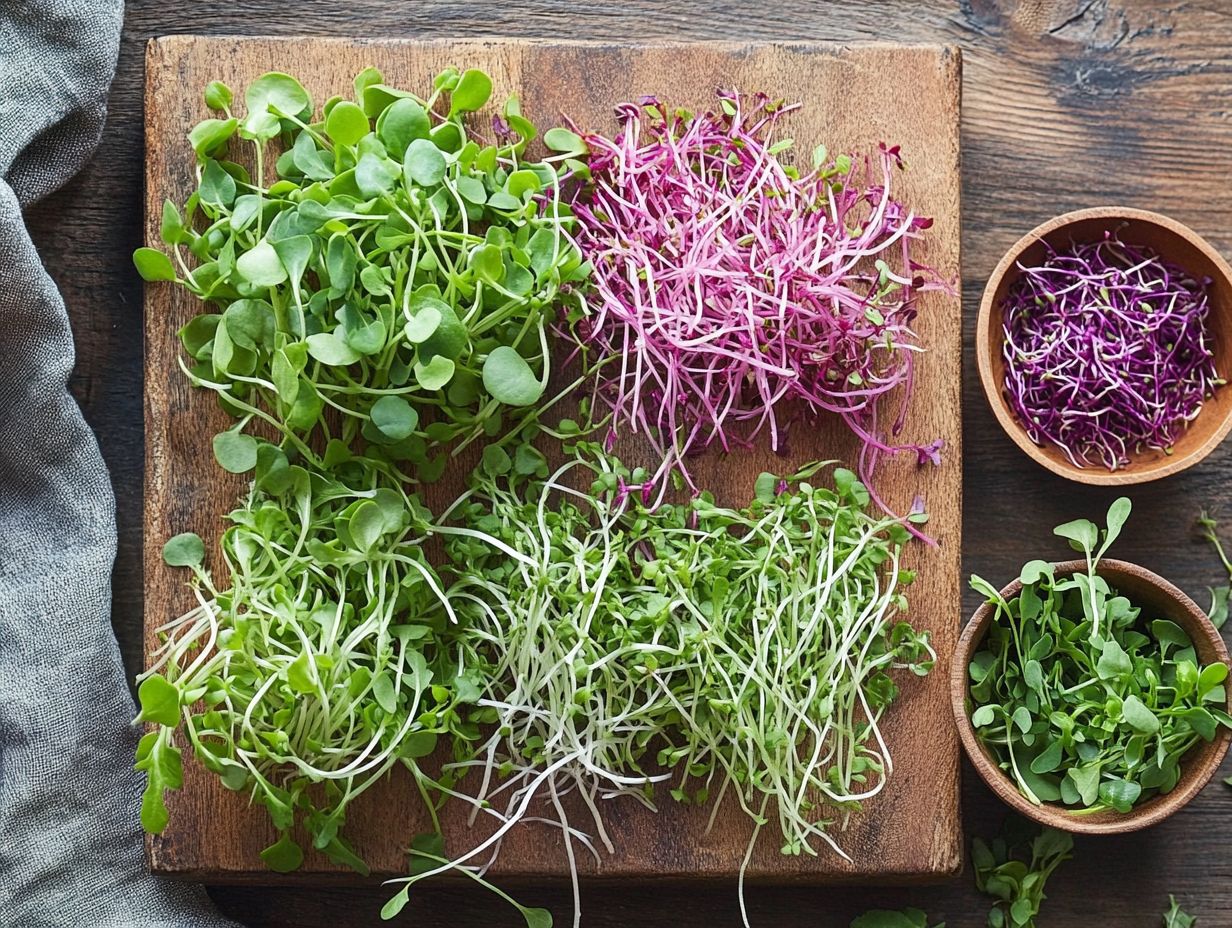
- Microgreens are small, nutrient-dense plants that pack a powerful punch of vitamins and minerals.
- Adding microgreens to your diet can improve digestion, boost your immune system, and reduce the risk of chronic diseases.
- Whether you grow your own or purchase them, microgreens are an easy and tasty addition to salads, smoothies, and other dishes for a healthy boost.
What are Microgreens?
Microgreens are the young, edible wonders you’ll want to embrace harvested just after those first true leaves make their debut. Often dubbed ‘vegetable confetti’, these small, vibrant greens deliver a remarkable nutritional punch, brimming with concentrated nutrients, potent antioxidants, and essential vitamins and minerals.
They belong to various plant families, including the illustrious Brassicaceae family, where beloved varieties like broccoli and red cabbage can be found. It’s no wonder that chefs and health enthusiasts alike hold these nutrient-dense gems in high regard for their culinary versatility and bold flavor profile, making them a sought-after staple in both home kitchens and upscale restaurants.
Definition and Types
Microgreens can be categorized into a variety of types, each with its own unique flavor and nutritional benefits, including broccoli, spinach, and fenugreek.
These vibrant little plants are typically harvested just after their first true leaves appear, making them not only a visually stunning addition to your dishes but also a powerhouse of nutrients. For instance, broccoli microgreens are celebrated for their high levels of sulforaphane, a compound that may help in fighting cancer. Meanwhile, spinach microgreens offer a concentrated source of vitamins A, C, and K. Exploring the benefits of growing diverse microgreen varieties ensures your meals are both nutritious and delicious.
Fenugreek, with its distinct, slightly sweet flavor, adds depth to your culinary creations while packing in beneficial antioxidants. Each variety requires specific growing conditions some love to bask in the sun on a windowsill, while others thrive in a hydroponic setup. This gives you a delightful array of options to enhance both the flavor and health of your meals.
Nutritional Value of Microgreens
The nutritional value of microgreens is truly remarkable. They boast a higher concentration of vitamins, minerals, and antioxidants compared to their mature counterparts, positioning them as essential components in any health-promoting diet. Microgreens are considered functional foods due to their multiple health benefits.
Incorporating microgreens into your meals can significantly enhance your nutritional intake and support your overall well-being. Exploring the best microgreen varieties for sprouting can help you get started.
Key Vitamins and Minerals

Microgreens are brimming with essential vitamins and minerals, such as vitamin C, vitamin K, and iron, delivering an impressive nutritional impact in remarkably small servings.
These miniature powerhouses do more than simply add flair to your salads; they are also loaded with antioxidants that help fight oxidative stress. For instance, vitamin C is pivotal in bolstering your immune system. Vitamin K is essential for maintaining strong bones and ensuring proper blood clotting. Incorporating the top 10 microgreens for nutritional boost can further enhance your diet. Iron plays a crucial role in transporting oxygen throughout your body, aiding in energy production and helping to stave off fatigue.
With such a wealth of nutrients, incorporating microgreens into your diet can significantly enhance your overall well-being, fend off chronic diseases, and promote a healthier lifestyle by choosing the best microgreens for nutritional value.
Health Benefits of Microgreens
The health benefits of microgreens go far beyond their remarkable nutritional profile. They significantly contribute to your overall well-being. These tiny powerhouses can boost your immune system and may even help protect against diseases, thanks to their rich content of plant chemicals that may protect against diseases and antioxidants.
Improved Digestion and Immune System
Incorporating microgreens into your diet can significantly enhance your gut health. This is due to their impressive dietary fiber content, which supports digestion and boosts your immune system.
These tiny greens are brimming with essential nutrients and antioxidants, making them an exceptional choice for anyone aiming to elevate their overall well-being. If you’re interested in incorporating these greens into your meals, check out the top microgreen varieties for gourmet cooking. The dietary fiber in microgreens plays a pivotal role in fostering a healthy gut environment, aiding in the efficient breakdown of food and absorption of nutrients.
Improved digestion not only alleviates gastrointestinal discomfort but also fortifies your immune system. A healthy gut serves as your body s frontline defense against illness. Research indicates that consuming fiber-rich foods correlates with better immunity, underscoring how adding these vibrant greens can have a far-reaching impact on your health.
Try adding microgreens to your next meal for a health boost!
Reduced Risk of Chronic Diseases
A diet rich in microgreens can significantly lower your risk of chronic ailments like heart disease and type 2 diabetes. These little powerhouses are loaded with antioxidants that help you manage your blood sugar levels effectively.
Microgreens are also packed with vitamins and minerals that support your overall health. Recent studies suggest that adding these plants that are good for you to your diet may even play a role in cancer prevention by combating oxidative stress (which can harm your cells) and inflammation, both of which are often linked to tumor development. Additionally, exploring ways to enhance flavor in microgreens can make them a delicious addition to your meals.
Research emphasizes that regularly incorporating microgreens can enhance your insulin sensitivity, making them a valuable ally for those dealing with insulin resistance. The benefits don’t stop there! Some findings indicate that microgreens can help regulate blood pressure, and exploring this quick guide to common microgreen varieties contributes to a holistic approach to disease prevention.
How to Incorporate Microgreens into Your Diet
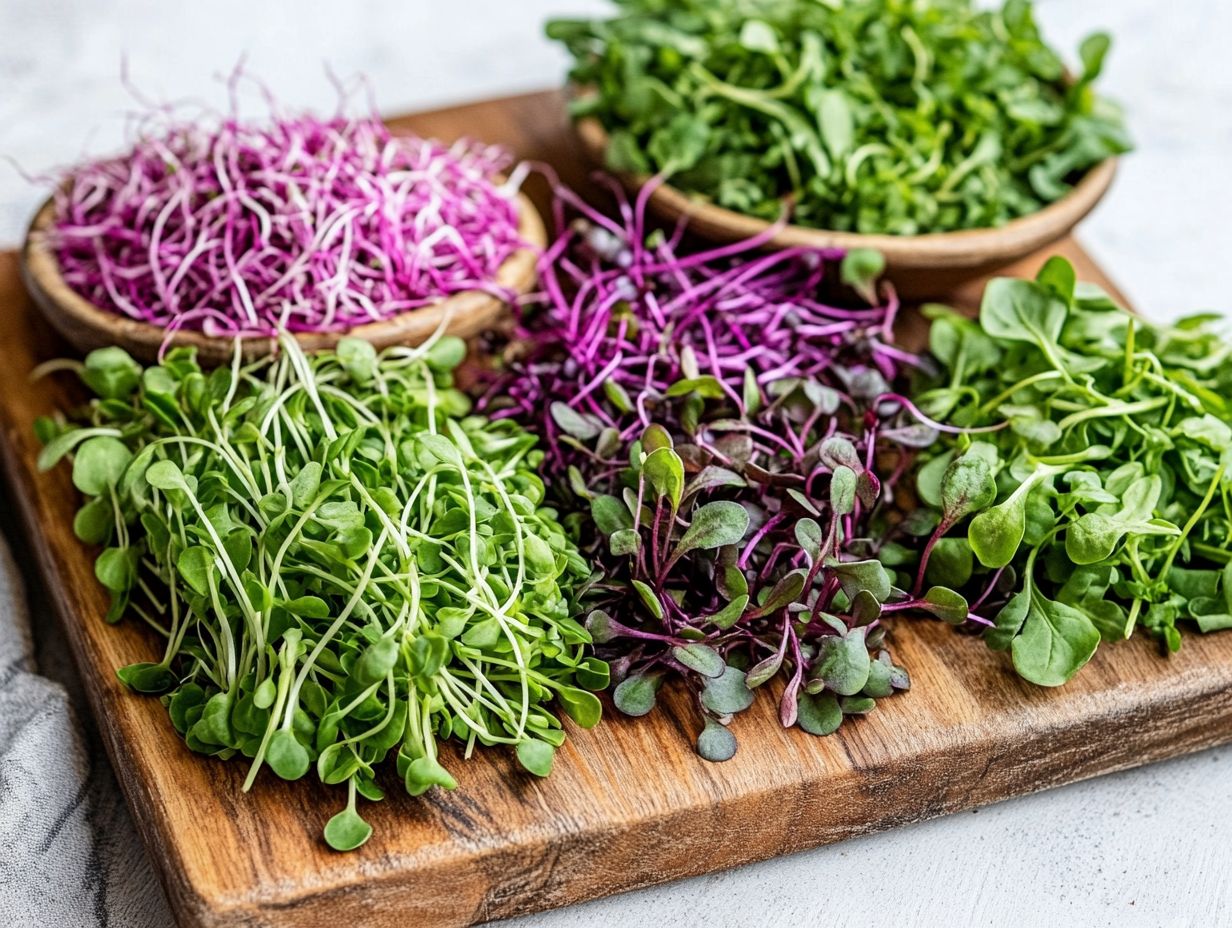
Adding microgreens to your meals is a fun and easy way to boost your intake of essential vitamins and minerals. These vibrant little greens offer countless culinary possibilities, enhancing everything from salads to sandwiches and even serving as exquisite garnishes.
Recipe Ideas and Tips
From fresh salads to gourmet garnishes, you have a wealth of recipe ideas at your fingertips, showcasing the culinary versatility and health benefits of microgreens.
These vibrant greens can elevate any dish! Whether you’re whipping up a simple breakfast omelet, crafting a luxurious seafood platter, or assembling a hearty grain bowl, microgreens are your secret ingredient. For instance, adding pea shoots introduces a delightful sweet, nutty flavor to your salads, while arugula microgreens deliver a peppery kick that elevates pizzas and charcuterie boards. Explore the top microgreen varieties for health enthusiasts to enhance your culinary creations.
To further enhance flavors, consider toasting sesame or pumpkin seeds for a satisfying crunch, or drizzle a zesty lemon vinaigrette over a bed of microgreens to brighten the entire dish. When you pair these tiny greens with ingredients like creamy avocado, earthy beets, or roasted vegetables, the delightful contrast of textures and tastes can truly transform your everyday meals into gourmet experiences. Discover why microgreens are superfoods you need for added health benefits in your diet.
Don’t forget, picking fresh, colorful microgreens is crucial to make every dish exciting! Selecting vibrant, fresh microgreens not only elevates the aesthetic appeal of your dishes but also reinforces their nutritional value. For more insights, check out the health benefits of microgreens explained, making your culinary creations as healthful as they are beautiful.
Growing Your Own Microgreens
Growing your own microgreens at home is entirely within your reach. Not only does it provide you with a fresh supply of nutrient-dense greens, but it also cultivates a more profound connection to your food.
Simple Steps and Supplies
To successfully grow microgreens, you ll need a few essential supplies, including seeds, soil, and trays. Having a straightforward process for planting and nurturing them is crucial. A spray bottle for watering, a grow light for cloudy days, and some fertilizer can elevate your growing experience.
- Start by choosing high-quality seeds. These are the cornerstone of vibrant, healthy microgreens.
- Prepare your trays with a special soil that helps plants grow better, ensuring it’s evenly moist but not soggy. Think of it as the perfect bed for your greens.
- Plant the seeds according to the instructions typically about a quarter to half an inch deep and create a dark, warm environment for germination.
- Once the seeds sprout, they ll bask in bright, indirect light to encourage robust growth.
- Regular misting of the soil and keeping an eye out for pests will support your journey to a successful microgreen harvest.
Frequently Asked Questions
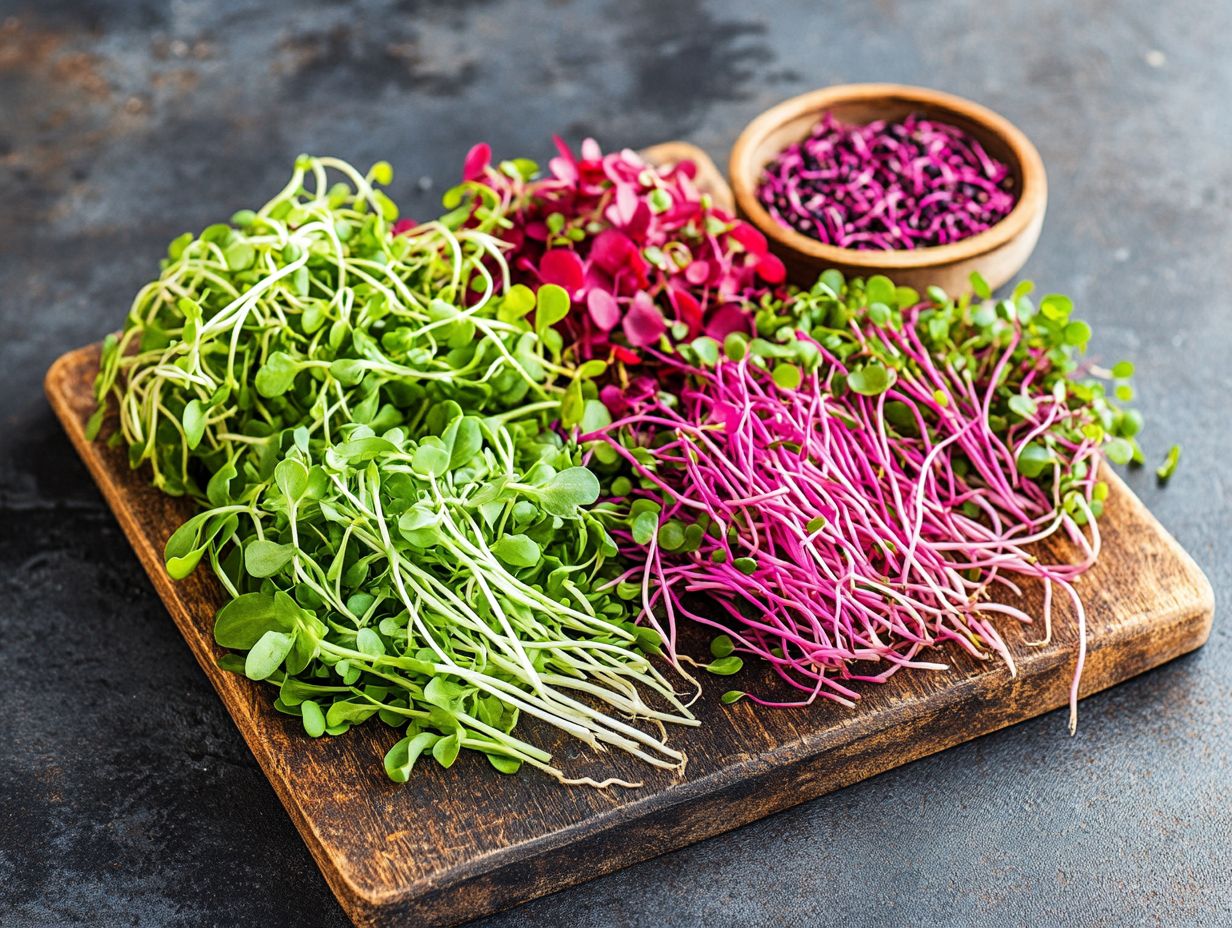
Discover the Nutritional Power of Microgreens!
Microgreens are young, edible plants harvested when they are only a few inches tall. They are packed with nutrients, including vitamins, minerals, and antioxidants, making them a great addition to any diet.
What Types of Microgreens Should You Grow?
Some common microgreens include broccoli, kale, radish, and pea shoots. Broccoli microgreens are high in vitamins A, C, and K. Kale microgreens are rich in iron and vitamin C. Radish microgreens are a good source of folate, while pea shoot microgreens are high in vitamins B and C.
How to Use Microgreens in Your Meals?
Get creative! Add microgreens to salads, sandwiches, wraps, smoothies, and even as a garnish on various dishes. They can also be enjoyed on their own as a healthy snack.
The Health Benefits of Microgreens
Regular consumption of microgreens has been linked to improved digestion, increased energy levels, and decreased inflammation. They may also have anti-cancer and anti-aging properties due to their high antioxidant content.
Can You Grow Microgreens at Home?
Yes! Microgreens can easily be grown at home in a small space with minimal equipment. Homegrown microgreens may have higher nutritional benefits compared to store-bought ones, as they are harvested at peak freshness and can be eaten immediately after harvesting.
Who Can Benefit from Microgreens?
Microgreens can benefit anyone looking to increase their nutrient intake, especially those at risk for chronic ailments such as heart disease, Type 2 diabetes, and Alzheimer s disease. They are particularly beneficial for pregnant or breastfeeding women, children, and older adults who have increased nutrient needs.
Start growing your microgreens today for a healthy boost!


